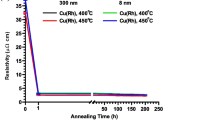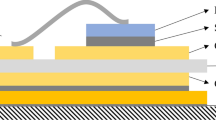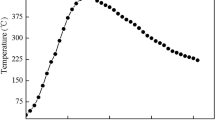Abstract
In soldering process, oxygen trapped in solder often leads to reliability issues. In order to determine basic mechanisms, five commercial Au-20Sn solder preforms with different oxygen content were studied. The XPS results revealed that the surface oxides on Au-20Sn solder are composed of SnO2 and SnO, and the ratio of soldering area suffered an obvious decline from 95.2 to 69.8% with the oxygen content increase from 16 to 69 ppm. The presence of oxygen will generate two types of voids, microvoids and macrovoids, forming in the solder joints. The shear test indicated that as the ratio of soldering area increased, the shear strength of solder joints continued to increase. During the fracture process, the pores and cracks appeared on the fracture surface when the oxygen content reached 42 ppm. In addition, this paper focus on investigating the aging time effect on defect evolution and shear strength of Au-20Sn solder joints at various oxygen levels. With the extension of aging time, the shear strength of higher oxygen content solder joints decreases more seriously. Considering the microstructure as well as the shear strength of solder joints, the critical oxygen content is preferably less than 28 ppm when Au–20Sn solders are used for fluxless bonding.













Similar content being viewed by others
References
Z.X. Zhu, C.C. Li, L.L. Liao, C.K. Liu, C.R. Kao, J. Alloys Compd. 671, 340 (2016)
C. Durand, M. Klingler, M. Bigerelle, D. Coutellier, Microelectron. Reliab. 66, 122 (2016)
B.S. Lee, Y.H. Ko, J.H. Bang, C.W. Lee, S. Yoo, J.K. Kim, J.W. Yoon, Microelectron. Reliab. 71, 119 (2017)
D. Bušek, K. Dušek, D. Růžička, M. Plaček, P. Mach, J. Urbánek, J. Starý, Microelectron. Reliab. 60, 135 (2016)
V. Verdingovas, M.S. Jellesen, R. Ambat, J. Electron. Mater. 44, 1116 (2015)
D.X. Xu, Y.P. Lei, Z.D. Xia, F. Guo, Y.W. Shi, J. Electron. Mater. 37, 125 (2008)
M.S. Jellesen, D. Minzari, U. Rathinavel, P. Møller, R. Ambat, Eng. Fail. Anal. 17, 1263 (2010)
J.W. Elmer, R.P. Mulay, Scripta Mater. 120, 14 (2016)
G.S. Zhang, H.Y. Jing, L.Y. Xu, J. Wei, Y.D. Han, J. Alloys Compd. 476, 138 (2009)
H. Chung, C. Chen, C. Lin, C. Chen et al., J. Alloys Compd. 485, 219 (2009)
J.W. Yoon, H.S. Chun, S.B. Jung, Mater. Sci. Eng. A 473, 119 (2008)
B.S. Lee, C.W. Lee, J.W. Yoon, Surf. Interface. Anal 48, 493 (2016)
P.J. Wang, J.S. Kim, C.C. Lee, J. Electron. Mater. 38, 2106 (2009)
J.A. Taylor, S.M. Merchant, D.L. Perry, J. Appl. Phys. 78, 5356 (1995)
J.F. Kuhmann, A. Preuss, B. Adolphi, K. Maly, T. Wirth, W. Oesterle, W. Pittroff, G. Weyer, M. Fanciulli, IEEE Trans. Compon. Packag. Manuf. Technol. C 21, 134 (1998)
S.S. Zhang, Y. Zhang, H. Wang, J. Alloys Compd. 487, 682 (2009)
Y.T. Lai, C.Y. Liu, J. Electron. Mater. 35, 28 (2006)
L. Wen, S.B. Xue, J.X. Wang, W.M. Long, S.J. Zhong, J. Mater. Sci-Mater. Electron. 30, 9489 (2019)
N. Birks, G.H. Meier, F.S. Pettit, Corrosion. 63, 104 (2007)
X. Luo, W. Du, X.Z. Lu, T. Yamaguchi, G. Jackson, L.L. Ye, L.J. Liu, Solder Surf. Mt. Tech. 25, 39 (2013)
T. Farrell, Met. Sci. 10, 87 (1976)
J. Peng, R.C. Wang, M. Wang, H.S. Liu, J. Electron. Mater. 46, 2021 (2017)
J.W. Yoon, H.S. Chun, S.B. Jung, J. Mater. Res. 22, 1219 (2007)
F. Arabi, L. Theolier, D. Martineaub, J.-Y. Deletage, M. Medina, E. Woirgard, Microelectron. Reliab. 64, 409 (2016)
Acknowledgements
This project was supported by National Natural Science Foundation of China (Grant No. 51675269), the State Key Laboratory of Advanced Brazing Filler Metals & Technology (Zhengzhou Research Institute of Mechanical Engineering), China (Grant No. SKLABFMT201704), and the Priority Academic Program Development of Jiangsu Higher Education Institutions (PAPD).
Author information
Authors and Affiliations
Corresponding author
Additional information
Publisher's Note
Springer Nature remains neutral with regard to jurisdictional claims in published maps and institutional affiliations
Rights and permissions
About this article
Cite this article
Wang, L., Xue, S., Liu, H. et al. Effect of oxygen content on reliability of Au-20Sn solder joints for the chip-level package. J Mater Sci: Mater Electron 31, 1411–1420 (2020). https://doi.org/10.1007/s10854-019-02655-5
Received:
Accepted:
Published:
Issue Date:
DOI: https://doi.org/10.1007/s10854-019-02655-5




